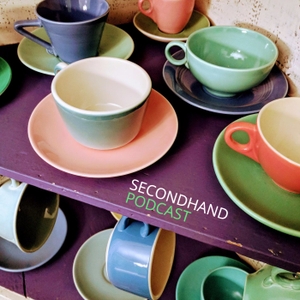
Mid-20th Century Design
03.03.2018 - By Bert Jerred
Download our free app to listen on your phone
Mid-20th Century Design
All week, I’d been teaching about information – how to find it, how to evaluate it, how to use it. So, for this secondhand quest, I went out looking for things related to information systems and I found it in the form of Mid-20th Century Design. Specifically, I found two cool records and three engrossing books at one of my favorite thrift stores in the suburbs of Syracuse – and one I like, specifically, for their book selection. I’ve been coming here for years, and they really keep the inventory moving. For junk enthusiasts like me, this keeps the game alive and suspenseful.
Audio Clip: El Cumbanchero, written by Rafael Hernández Marín and recorded by Charles Magnante for Command Records in 1964. Cover art by George Giusti.
In my last episode, I was preoccupied with stories of justice and reinvention. I looked into The Lego Group’s complex system of corporate governance, the Android ecosystem as an example of clever and determined re-purposing, and a political memoir, which served as a lens through which I could re-evaluate the dynamics of current events. For this episode, the workday spillover is about information systems. The question I am asking myself is this: In what ways might information systems influence our understanding of cultural priorities? Is this influence overt, or implicit? And, finally, how might a few semi-random secondhand artifacts reflect shifting cultural values?
Advertising Design
The books I found are design annuals from the 1940s and ’50s. These are fascinating visual summaries of advertising art, and they provide an overwhelmingly complex study of social and technological information. Color, symbol, abstraction, perspective – all analytical fields in which I have no expertise. But, like the records I’m listening to from the ’60s, they also provide something that seems to be timeless. The other vinyl that I found is called, “Let’s Dance the Bossa Nova,” recorded by Enoch Light and his Orchestra – again, for Command records.
Audio Clip: O Barquinho, written by Roberto Menescal and recorded for Command Records in 1963. Cover art by Charles E. Murphy.
All told, I spent about $5 on what could easily be months of self-guided study. I don’t pose these questions because I have some sophisticated answer, but I suspect there is something worthwhile in the effort of looking back. And, more to the point of this podcast, I can try to understand the shifting nature of value by refining my original questions.
What I Read in These Secondhand Finds
I read in these international advertisements a fascination with the exotic, primal things within; the core-level symbolism that is ambiguous while its immediacy is arresting; a colorful pause in the heretofore prevalent constructs of “traditional” relationships; I read playful ferocity; I read the obituary of typesetting, the birth of televised commercials with cartoon ch

